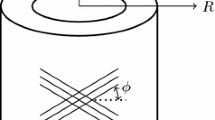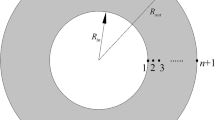Abstract
Traditional constitutive frameworks for high-strain materials are ill-suited to solve extension and inflation, one of the simplest problems involving tubes, or more complicated problems. Moreover, it is experimentally necessary to minimize the covariance amongst constitutive response functions. We sought, hence, a constitutive framework that minimizes covariance and simplifies the balance equations for tubes, hoses, and arteries. Central to this theory are six objective scalars or strain attributes that decouple dilatation and distortion and succinctly define the strain. Because there is a one-to-one relationship between them and the components of the Right Cauchy–Green deformation tensor, these six strain attributes can be used to define the strain energy density function for hyperelastic materials. This approach yields mostly orthogonal response terms for high strain deformation (14 of the 15 inner products vanish). For infinitesimal deformation, the response terms are fully orthogonal. Further utility is demonstrated by showing how the governing equations are simplified for tubular structures and how response functions can be determined for the first time from the extension and inflation of thick-walled tubes composed of a homogeneous material with incompressible, hyperelastic behavior. This solution is applicable for materials with orthotropic behavior, and using the chain rule, this solution can be used for materials with isotropic behavior.
Similar content being viewed by others
References
S.N. Atluri, Alternate stress and conjugate strain measures, and mixed variational formulations involving rigid rotations, for computational analyses of finitely deformed solids, with application to plates and shells – I. Computers Structures 18(1) (1984) 93–116.
J.C. Criscione, Rivlin’s representation formula is ill-conceived for the determination of response functions via biaxial testing. J. Elasticity 70 (2003) 129–147.
J.C. Criscione, A.S. Douglas and W.C. Hunter, Physically based strain invariant set for materials exhibiting transversely isotropic behavior. J. Mech. Phys. Solids 49 (2001) 871–897.
J.C. Criscione, J.D. Humphrey, A.S. Douglas and W.C. Hunter, An invariant basis for natural strain which yields orthogonal stress response terms in isotropic hyperelasticity. J. Mech. Phys. Solids 48 (2000) 2445–2465.
J.C. Criscione and W.C. Hunter, Kinematic framework for materials with two separate families of parallel fibers. Continuum Mech. Thermodynamics 15 (2003) 613–628.
J.C. Criscione, A.D. McCulloch and W.C. Hunter, Constitutive framework optimized for myocardium and other high-strain, laminar materials with one fiber family. J. Mech. Phys. Solids 50 (2002) 1681–1702.
P.J. Flory, Thermodynamic relations for high elastic materials. Trans. Faraday Soc. 57 (1961) 829–838.
Y.C. Fung, Biomechanics: Mechanical Properties of Living Tissues. Springer, New York (1993) p. 281.
M.E. Gurtin, An Introduction to Continuum Mechanics. Academic Press, San Diego (1981) pp. 63, 71, 110.
J.D. Humphrey, Cardiovascular Solid Mechanics: Cells, Tissues, and Organs. Springer, New York (2002) Chapters 4, 7.
L.E. Malvern, Introduction to the Mechanics of a Continuous Medium. Prentice-Hall, Englewood Cliffs, NJ (1969) p. 284.
R.W. Ogden, Non-linear Elastic Deformations. Dover Press, Mineola, NY (1997) pp. 88, 122, 156.
G.F. Smith, Constitutive Equations for Anisotropic and Isotropic Materials. North-Holland, Amsterdam (1994).
Smith and Rivlin, The strain-energy function for anisotropic elastic materials. Trans. Amer. Math. Soc. 88 (1958) 175–193.
A.J.M. Spencer, Constitutive theory for strongly anisotropic solids. In: A.J.M. Spencer (ed.), Continuum Theory of the Mechanics of Fibre-Reinforced Composites. Springer, New York (1984) pp. 1–32.
Author information
Authors and Affiliations
Corresponding author
Rights and permissions
About this article
Cite this article
Criscione, J.C. A Constitutive Framework for Tubular Structures that Enables a Semi-inverse Solution to Extension and Inflation. J Elasticity 77, 57–81 (2004). https://doi.org/10.1007/s10659-005-2155-7
Received:
Published:
Issue Date:
DOI: https://doi.org/10.1007/s10659-005-2155-7




